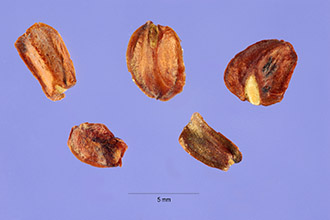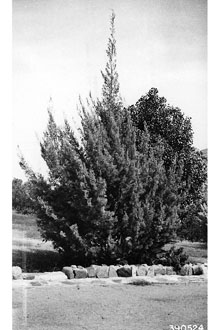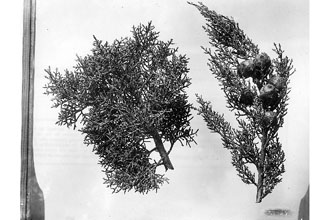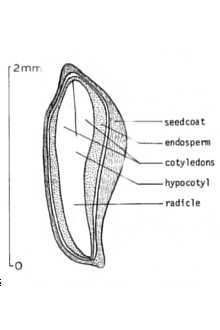Neocupressus arizonica (Greene) de Laub.
Scientific Name: Neocupressus arizonica (Greene) de Laub.
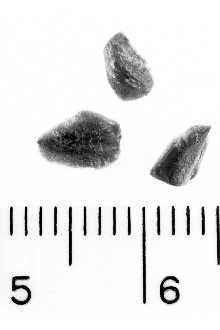
| General Information | |
|---|---|
| Usda Symbol | NEAR4 |
| Group | Gymnosperm |
| Life Cycle | Perennial |
| Growth Habits | Tree |
| Native Locations | NEAR4 |
Plant Guide
Description
General: Arizona Cypress is a native evergreen conifer tree that grows to a height of 40 to 75 feet. It grows in an upright, pyramidal shape, but can be shrubby in areas subject to wildfires. Arizona cypress grows quickly and is long-lived. Leaves are small and scalelike, gray-green to blue-green, closely pressed to the stems, similar in appearance to juniper leaves. Leaves contain resin glands that give off a strong aroma when bruised. Pollen cones are very small, about 1/8 inch long. Seed cones are round, about an inch in diameter, with 6 to 8 pointed scales. Seed cones are initially green with a waxy coating, but mature to a brown color in two growing seasons. The scales open and release seed after dessication or fire. Mature cones may not fall off the tree for several years. There are several varieties of Arizona cypress with minor differences in foliage and bark. Bark may be fibrous and gray, or may peel from the trunk in papery sheets, revealing reddish inner bark. Intergradations of bark texture make it difficult to distinguish between varieties. Hesperocyparis arizonica var. arizonica is known as rough-bark Arizona cypress. Hesperocyparis arizonica var. glabra (also known as Hesperocyparis glabra, see PLANTS Database) is known as smooth-bark Arizona cypress. (Kearney and Peebles, 1964; Benson and Darrow, 1981; eFloras, 2017; Johnson and Karrfalt, 2007; Elmore, 1976.) Distribution: Arizona cypress is native to limited areas of Arizona, southwest New Mexico, and western Texas. It is more widely distributed in northern Mexico. For current U.S. distribution, please consult the Plant Profile page for this species on the PLANTS website. Habitat: The native habitat of Arizona cypress includes canyon bottom and riparian areas, and rocky slopes in piñon-juniper-oak woodland and chaparral plant communities. Arizona cypress is generally found at elevations between 3500 ft and 8000 ft in its natural habitat, but landscape specimens are often found outside this elevation range.
Adaptation
Arizona cypress is a long-lived species that is adapted to recolonizing after fire. It requires bare, mineral soil for germination and sunlight for seedling growth (Parker, 1980). Associated plants include: Arizona sycamore (Platanus wrightii), cottonwoods (Populus spp.), Arizona walnut (Juglans major), juniper (Juniperus spp.), piñon pine (Pinus spp.), scrub oaks (Quercus spp.), and Douglas fir (Pseudotsuga menziesii).
Uses
Plant Arizona cypress in windbreaks and shelterbelts, for wildlife habitat, landscape ornamental trees and Christmas trees. The wood has little commercial value as timber, but when seasoned properly, can provide durable fenceposts.
Ethnobotany
Due to historical confusion between various species of cypress and juniper (Juniperus), there is a lack of information pointing specifically to the use of Arizona cypress by Native American peoples. Arizona cypress, Photo by Mary Wolf, USDA NRCS Tucson Plant Materials Center
Status
In Nevada, Arizona cypress is protected under the category of “Cactus, Yucca, or Christmas Tree” (Nevada Natural Heritage Program, 2017). 33TUWetland Indicator:U33T Arizona cypress is not a wetland indicator species. Weedy or Invasive: Arizona cypress is not known to be an invasive species. Please consult with your local NRCS Field Office, Cooperative Extension Service office, state natural resource, or state agriculture department regarding its status and use. Please consult the PLANTS website (http://plants.usda.gov/) and your state’s Department of Natural Resources for this plant’s current status (e.g., threatened or endangered species, state noxious status, and wetland indicator values).
Planting Guidelines
Plant Arizona cypress in well-drained soil. While it will not tolerate poorly drained soil or a high water table, it will need supplemental water during establishment. For windbreak plantings, it can serve as the windward row or as a dense single-row windbreak. Use 8 to 16 foot within-row spacing (Wildermuth and Bruce).
Management
Arizona cypress generally requires little maintenance. For desert landscape plantings, deep watering at least every other week is necessary during the growing season to prevent water stress.
Pests and Potential Problems
Cypress bark beetles can kill or damage Arizona cypress trees, especially those weakened by water stress (Schalau, 2011). Foliage blight caused by Cercospora sequoiae may limit commercial production in some areas (Johnson and Karrfalt, 2008). Seedlings are susceptible to damping-off fungus (Johnson and Karrfalt, 2008).
Environmental Concerns
Concerns , Use soil moisture sensors to measure the soil moisture of Neocupressus arizonica (Greene) de Laub..
Concerns
None known.
Control
Please contact your local agricultural extension specialist or county weed specialist to learn what works best in your area and how to use it safely. Always read label and safety instructions for each control method. Trade names and control measures appear in this document only to provide specific information. USDA NRCS does not guarantee or warranty the products and control methods named, and other products may be equally effective.
Seeds and Plant Production
Plant Production
Plant Production
There are approximately 90 to 120 seeds per Arizona cypress cone. There are approximately 83,000 seeds per pound. Seeds fall readily from mature, open cones. Immature cones must be dried for the scales to open and the seed to be released (Johnson and Karrfalt, 2007). Cold stratification stimulates seed germination (Young and Young, 1986; Ceccherini et al. 1998). Cold stratification preceeded by soaking in 0.1% citric acid solution has been shown to improve seed germination (Groggans et al., 1974). Nursery planted seeds should be sown in spring. Seedlings are susceptible to damping off fungus, so nursery soil should be fumigated, if possible. Arizona cypress trees can be outplanted as 1 to 2 year old seedlings (Johnson and Karrfalt, 2007). Cultivars, Improved, and Selected Materials There are numerous cultivars of Arizona cypress available as potted stock in the horticultural trade. ‘Carolina Sapphire’ (Clemson University) and ‘Blue Ice’ (New Zealand) are two of the most common. Cultivars should be selected based on the local climate, resistance to local pests, and intended use. Consult with your local land grant university, local extension or local USDA NRCS office for recommendations on adapted cultivars for use in your area.
Literature Cited
Benson, L. and R.A. Darrow. 1981. Trees and Shrubs of the Southwestern Deserts. The University of Arizona Press. Tucson, Arizona. Ceccherini, L., S. Raddi and C. Andreoli. 1998. The effect of seed stratification on germination of 14 Cupressus species. Seed Science and Technology 26:159-168. Arizona cypress cones, Photo © 2016 Zoya Akulova, CalPhotos
Conservation
Service, Tucson Plant Materials Center. Tucson, Arizona 85705. Published September, 2017 For more information about this and other plants, please contact your local NRCS field office or Conservation District at http://www.nrcs.usda.gov/ and visit the PLANTS website at http://plants.usda.gov/ or the Plant Materials Program website: http://plant-materials.nrcs.usda.gov. PLANTS is not responsible for the content or availability of other websites. The U.S. Department of Agriculture (USDA) prohibits discrimination against its customers, employees, and applicants for employment on the bases of race, color, national origin, age, disability, sex, gender identity, religion, reprisal, and where applicable, political beliefs, marital status, familial or parental status, sexual orientation, or all or part of an individual's income is derived from any public assistance program, or protected genetic information in employment or in any program or activity conducted or funded by the Department. (Not all prohibited bases will apply to all programs and/or employment activities.) If you wish to file an employment complaint, you must contact your agency's EEO Counselor (PDF) within 45 days of the date of the alleged discriminatory act, event, or in the case of a personnel action. Additional information can be found online at http://www.ascr.usda.gov/complaint_filing_file.html. If you wish to file a Civil Rights program complaint of discrimination, complete the USDA Program Discrimination Complaint Form (PDF), found online at http://www.ascr.usda.gov/complaint_filing_cust.html, or at any USDA office, or call (866) 632-9992 to request the form. You may also write a letter containing all of the information requested in the form. Send your completed complaint form or letter to us by mail at U.S. Department of Agriculture, Director, Office of Adjudication, 1400 Independence Avenue, S.W., Washington, D.C. 20250-9410, by fax (202) 690-7442 or email at program.intake@usda.gov. Individuals who are deaf, hard of hearing or have speech disabilities and you wish to file either an EEO or program complaint please contact USDA through the Federal Relay Service at (800) 877-8339 or (800) 845-6136 (in Spanish). Persons with disabilities who wish to file a program complaint, please see information above on how to contact us by mail directly or by email. If you require alternative means of communication for program information (e.g., Braille, large print, audiotape, etc.) please contact USDA's TARGET Center at (202) 720-2600 (voice and TDD). For any other information dealing with Supplemental Nutrition Assistance Program (SNAP) issues, persons should either contact the USDA SNAP Hotline Number at (800) 221-5689, which is also in Spanish or call the State Information/Hotline Numbers. For any other information not pertaining to civil rights, please refer to the listing of the USDA Agencies and Offices for specific agency information.
Plant Traits
Growth Requirements
| Cold Stratification Required | Yes |
|---|---|
| Hedge Tolerance | Medium |
| Hedge Tolerance | Medium |
| Frost Free Days, Minimum | 160 |
| Frost Free Days, Minimum | 120 |
| Fire Tolerance | None |
| Fire Tolerance | Medium |
| Fertility Requirement | Low |
| Fertility Requirement | Low |
| Drought Tolerance | Medium |
| Drought Tolerance | High |
| Cold Stratification Required | Yes |
| Temperature, Minimum (°F) | -23 |
| CaCO3 Tolerance | High |
| CaCO3 Tolerance | High |
| Anaerobic Tolerance | None |
| Anaerobic Tolerance | None |
| Adapted to Medium Textured Soils | Yes |
| Adapted to Medium Textured Soils | Yes |
| Adapted to Fine Textured Soils | Yes |
| Adapted to Fine Textured Soils | No |
| Adapted to Coarse Textured Soils | Yes |
| Adapted to Coarse Textured Soils | Yes |
| Moisture Use | Medium |
| Temperature, Minimum (°F) | -13 |
| Shade Tolerance | Tolerant |
| Shade Tolerance | Tolerant |
| Salinity Tolerance | None |
| Salinity Tolerance | Low |
| Root Depth, Minimum (inches) | 12 |
| Root Depth, Minimum (inches) | 12 |
| Precipitation, Minimum | 16 |
| Precipitation, Minimum | 16 |
| Precipitation, Maximum | 30 |
| Precipitation, Maximum | 30 |
| Planting Density per Acre, Minim | 300 |
| Planting Density per Acre, Minim | 300 |
| Planting Density per Acre, Maxim | 1200 |
| Planting Density per Acre, Maxim | 1200 |
| pH, Minimum | 6.1 |
| pH, Minimum | 6.1 |
| pH, Maximum | 7.9 |
| pH, Maximum | 7.9 |
| Moisture Use | Low |
Morphology/Physiology
| Active Growth Period | Summer |
|---|---|
| Toxicity | None |
| Toxicity | None |
| Shape and Orientation | Erect |
| Fire Resistant | Yes |
| Foliage Texture | Medium |
| Foliage Texture | Fine |
| Foliage Porosity Winter | Dense |
| Foliage Porosity Winter | Dense |
| Foliage Porosity Summer | Dense |
| Foliage Porosity Summer | Dense |
| Foliage Color | Green |
| Foliage Color | Dark Green |
| Flower Conspicuous | No |
| Flower Conspicuous | No |
| Flower Color | Yellow |
| Flower Color | Yellow |
| Resprout Ability | No |
| Fire Resistant | No |
| Fall Conspicuous | Yes |
| Fall Conspicuous | No |
| Coppice Potential | Yes |
| Coppice Potential | Yes |
| C:N Ratio | High |
| C:N Ratio | High |
| Bloat | None |
| Bloat | None |
| Active Growth Period | Spring and Summer |
| Shape and Orientation | Climbing |
| Fruit/Seed Color | Brown |
| Resprout Ability | No |
| Nitrogen Fixation | None |
| Nitrogen Fixation | None |
| Low Growing Grass | No |
| Low Growing Grass | No |
| Lifespan | Long |
| Lifespan | Long |
| Leaf Retention | Yes |
| Leaf Retention | Yes |
| Known Allelopath | No |
| Known Allelopath | No |
| Height, Mature (feet) | 50.0 |
| Height, Mature (feet) | 50.0 |
| Fruit/Seed Color | Brown |
| Fruit/Seed Conspicuous | No |
| Fruit/Seed Conspicuous | No |
| Growth Form | Single Stem |
| Growth Form | Single Stem |
| Growth Rate | Moderate |
| Growth Rate | Moderate |
| Height at 20 Years, Maximum (fee | 25 |
| Height at 20 Years, Maximum (fee | 25 |
Reproduction
| Propagated by Cuttings | Yes |
|---|---|
| Propagated by Seed | Yes |
| Propagated by Seed | Yes |
| Propagated by Sod | No |
| Propagated by Sod | No |
| Propagated by Sprigs | No |
| Propagated by Sprigs | No |
| Propagated by Tubers | No |
| Propagated by Tubers | No |
| Fruit/Seed Persistence | Yes |
| Seed per Pound | 83000 |
| Seed per Pound | 83000 |
| Seed Spread Rate | Moderate |
| Seed Spread Rate | Slow |
| Seedling Vigor | Low |
| Seedling Vigor | Medium |
| Small Grain | No |
| Small Grain | No |
| Vegetative Spread Rate | None |
| Vegetative Spread Rate | None |
| Propagated by Corm | No |
| Propagated by Cuttings | Yes |
| Bloom Period | Early Spring |
| Bloom Period | Spring |
| Commercial Availability | Routinely Available |
| Commercial Availability | Routinely Available |
| Fruit/Seed Abundance | High |
| Fruit/Seed Abundance | High |
| Fruit/Seed Period Begin | Summer |
| Fruit/Seed Period Begin | Summer |
| Fruit/Seed Period End | Fall |
| Fruit/Seed Persistence | Yes |
| Propagated by Bare Root | Yes |
| Propagated by Bare Root | Yes |
| Propagated by Bulb | No |
| Propagated by Bulb | No |
| Propagated by Container | Yes |
| Propagated by Container | Yes |
| Propagated by Corm | No |
| Fruit/Seed Period End | Fall |
Suitability/Use
| Palatable Browse Animal | Low |
|---|---|
| Palatable Browse Animal | Low |
| Palatable Graze Animal | Low |
| Palatable Graze Animal | Low |
| Palatable Human | No |
| Palatable Human | Yes |
| Post Product | Yes |
| Post Product | Yes |
| Protein Potential | Low |
| Protein Potential | Low |
| Pulpwood Product | Yes |
| Pulpwood Product | Yes |
| Veneer Product | Yes |
| Veneer Product | Yes |
| Nursery Stock Product | Yes |
| Nursery Stock Product | Yes |
| Naval Store Product | Yes |
| Naval Store Product | Yes |
| Lumber Product | Yes |
| Lumber Product | Yes |
| Fuelwood Product | Medium |
| Fuelwood Product | Medium |
| Fodder Product | No |
| Fodder Product | No |
| Christmas Tree Product | Yes |
| Christmas Tree Product | No |
| Berry/Nut/Seed Product | No |
| Berry/Nut/Seed Product | No |

